Mad Hedge Biotech and Healthcare Letter
December 26, 2023
Fiat Lux
Featured Trade:
(A MARATHON, NOT A SPRINT)
(AMGN), (ABBV), (DNA), (PFE), (RHHBY), (GILD), (NVO)

Mad Hedge Biotech and Healthcare Letter
December 26, 2023
Fiat Lux
Featured Trade:
(A MARATHON, NOT A SPRINT)
(AMGN), (ABBV), (DNA), (PFE), (RHHBY), (GILD), (NVO)

Navigating the stock market, where fortunes are made and lost faster than a New York minute, can be as exhilarating as it is nerve-wracking.
And when you're hunting for that quick win, that short-term stock buy that'll make your year, you realize you're playing a game where even the big guns like Warren Buffett don't always have the magic crystal ball.
But let's pivot a bit. What about when you're not sweating under a cash crunch — when you can afford to play the long game?
That's when you shift your sights to those long-term compounders, the kind that churn out robust returns on capital like a well-oiled machine. Here, initial valuations play second fiddle to the long-term prospects.
This is where Amgen (AMGN) struts onto the stage. It's not just any old player in the biotechnology and healthcare arena; it's a front-runner with a knack for keeping its coffers brimming and its profitability soaring.
In terms of therapeutic innovation, Amgen is a leader in the fields of oncology, inflammation, neurology, and pulmonary diseases. Their biosimilar practice is also on the rise, churning out replicas of blockbuster drugs like AbbVie’s (ABBV) Humira and Genentech’s (DNA) Herceptin.
Essentially, investing in Amgen is like finding a gold mine in your backyard – and then realizing there's oil under there, too.
Now, let's talk numbers because that's where the rubber meets the road. Amgen's moat-worthy drug franchises make it as solid as a rock for those seeking stability in their cash flows, especially when economic clouds are gathering.
And in the healthcare segment, it's akin to building your house on a rock – it withstands economic storms.
Amgen is known for its industry-leading profitability, flashing its A+ grade like a badge of honor. Their 11% return on total capital and a jaw-dropping 134% return on equity? That's not just good; it's like winning the financial Olympics.
Over the last decade, Amgen's total return of 218% didn't just outdo the S&P 500; it left peers like Pfizer (PFE), Roche (RHHBY), and Gilead (GILD) in the dust. Sure, AbbVie is still ahead, but that's mostly thanks to their Humira magic.
Fast forward to the present, and Amgen's showing no signs of slowing down.
Their total revenue shot up by 4% YoY to $6.9 billion in the third quarter, courtesy of a surge in volumes across their star products. We're talking double-digit growth in BLINCYTO, EVENITY, Repatha, and Nplate. This is like watching a relay race where every runner is Usain Bolt.
Peeking into the future, Amgen's pipeline is a treasure trove of potential.
The company has six first-in-class oncology assets and three FDA Breakthrough Therapy designations. Mirroring Novo Nordisk's (NVO) success with Ozempic, Amgen’s wrapped up Phase 2 studies for their obesity contender, Maridebart cafraglutide.
But here's where it gets even more interesting. Amgen's leap into multi-specific drugs, particularly with tumor treatment AMG 193, is like stepping into a sci-fi novel – it's groundbreaking, it's futuristic, and it just might revolutionize drug delivery.
Let's not forget the FDA's priority review of tarlatamab for small-cell lung cancer. This isn't just good news; it's a potential game-changer, a sign that Amgen might just be first across the finish line in this high-stakes race.
Of course, the recent acquisition of Horizon Therapeutics adds another feather to Amgen's cap, expanding its rare disease portfolio. The incoming drugs from this deal, including Tavneos, Tepezza, KRYSTEXXA, and UPLIZNA, are in the early stages of their lifecycle, making them ripe for growth.
However, every silver lining has a cloud. The integration of Horizon Therapeutics carries its own set of risks, and Amgen's legacy drugs like Enbrel and Otezla face the ticking clock of declining sales.
We also can’t gloss over the elephant in the room – Amgen's ballooning long-term debt, expected to hit a whopping $65 billion by year-end. The recent downgrade of Amgen's credit rating to BBB is like a cautious tap on the shoulder, a reminder to tread carefully.
But don't let that dampen your spirits. Amgen's 3.3% dividend yield is as solid as it comes, with management showing a vote of confidence with a 5.6% raise for the upcoming Q1 2024 payout.
The company's history of rewarding shareholders through share buybacks – a 19% reduction in share count over five years is nothing to scoff at either.
So, where does that leave Amgen's valuation? At a current price of $275 and a forward PE of 14.8, it's not exactly a bargain basement, but it's far from sky-high. It's in that sweet spot where quality meets value.
For long-term investors who value stability and growth, consider adding Amgen to your portfolio playbook.
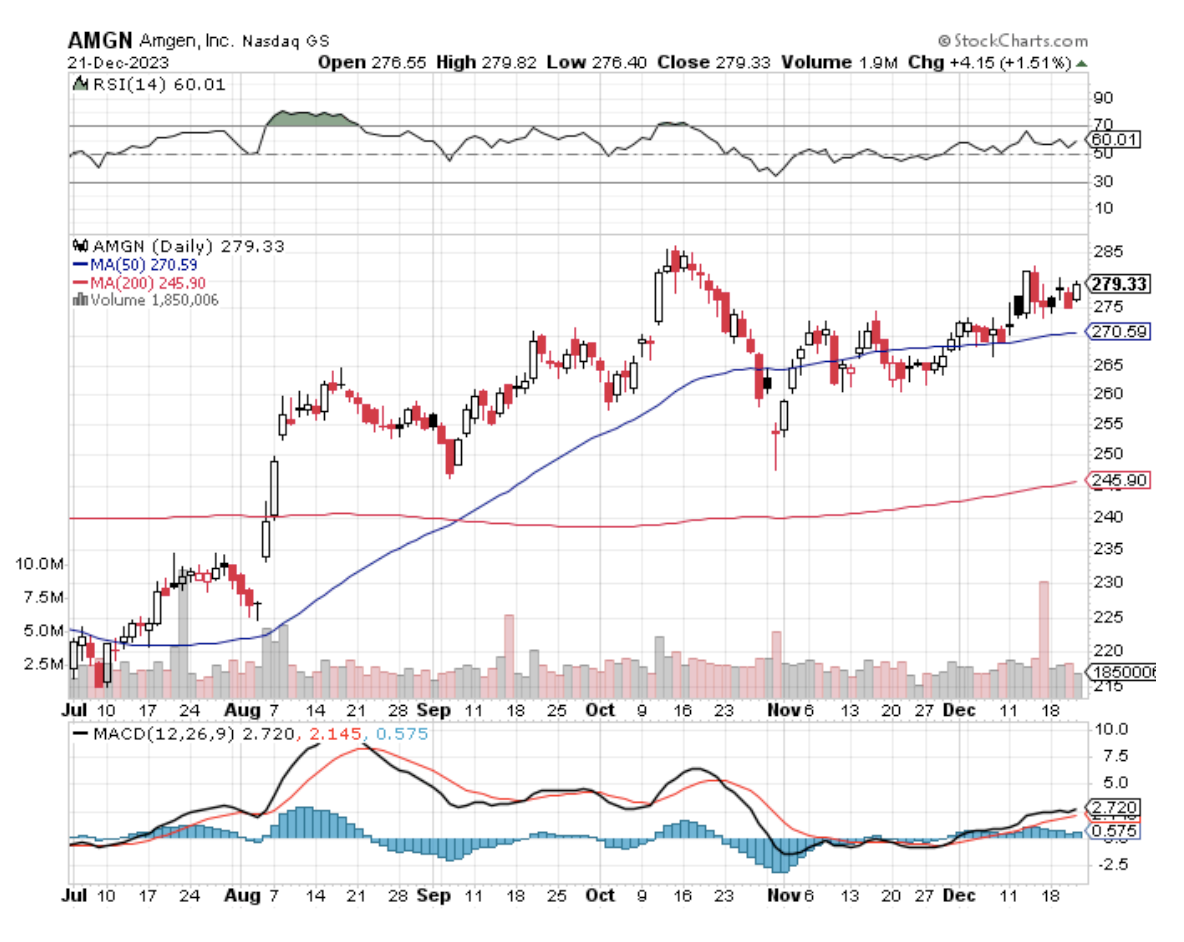
Mad Hedge Biotech and Healthcare Letter
December 7, 2023
Fiat Lux
Featured Trade:
(CHALLENGING THE MAGNIFICENT SEVEN)
(LLY), (NVO), (RHHBY), (AZN), (AMGN), (VKTX), (MSFT), (NVDA)
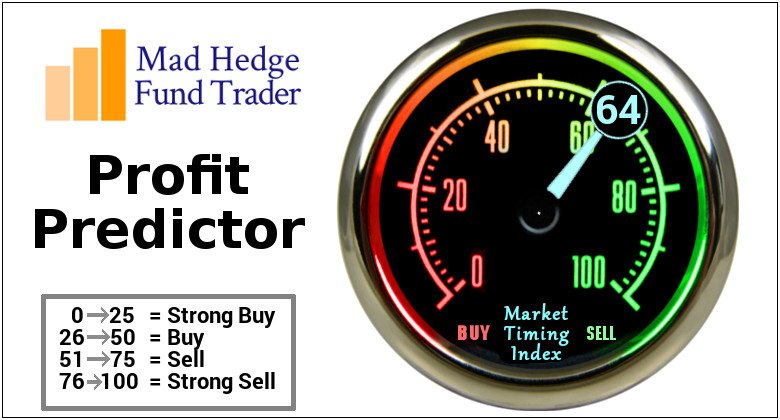
If you thought the S&P 500’s dance floor was exclusively reserved for tech's Magnificent Seven, including the likes of Microsoft (MSFT) and Nvidia (NVDA), think again.
Galloping up from behind, with the confidence of a new sheriff in town, are Eli Lilly (LLY) and Novo Nordisk (NVO), blazing trails in the obesity drug market.
Eli Lilly, with its freshly minted weight-loss drug, has catapulted to an eye-watering market value of nearly $600 billion. That's a leap from less than $100 billion in just over five years – talk about a growth spurt!
On the other side, we have Novo Nordisk, hailing from Denmark and thus not a part of the S&P club. Nevertheless, they're no slouches, sporting a hefty $450 billion market cap, quadrupling in value over five years.
The latest to throw their hat into this lucrative ring is Roche Holdings (RHHBY). They've just penned a $3.1 billion deal to acquire Carmot Therapeutics. This isn't just pocket change – it's a clear signal Roche wants a piece of the weight-loss pie, currently dominated by Eli Lilly and Novo Nordisk.
Carmot Therapeutics, a U.S.-based outfit, is cooking up something special in the GLP-1 receptor agonists segment, a class of drugs stirring up both the market and cultural scene.
Roche, by acquiring Carmot, gains exclusive dibs on three promising drugs, all at different stages of trial.
Now, let's talk numbers.
Roche is shelling out $2.7 billion upfront with another $400 million on the line, based on performance milestones. Analysts reckon Roche is gunning for phase III trials to crash the Eli Lilly and Novo party.
But let's not kid ourselves – it's an uphill battle for market share, considering the head start the other two have.
As for the market's reaction? Roche's stock perked up by 2.5% in Switzerland, although it's still trailing by 15% this year. Eli Lilly and Novo Nordisk, meanwhile, saw a bit of a dip in early trading, despite a strong showing this year.
Ultimately, Roche’s goal isn’t just to focus on the drugs. Instead, the company is eyeing an integrated approach, combining pharmaceuticals, diagnostics, and expertise in cardiovascular and metabolic diseases. It's like putting together a high-stakes puzzle where every piece matters.
Furthermore, other pharma giants are joining the fray. For example, AstraZeneca recently entered a $2 billion deal with China’s Eccogene for a nascent obesity and Type 2 diabetes drug.
But here's the million-dollar question: Are we seeing a bubble in these slimming stocks? It's hard to pin down.
What we do know is that the global obesity epidemic isn't slowing down, and these drugs are showing results.
Take Lilly’s tirzepatide, for instance – it's making waves as both diabetes and obesity treatment, with trial participants shedding an average of 52 pounds.
The financial forecasts are staggering, projecting potential annual sales of $67 billion by 2032, and possibly $100 billion by 2030.
This means obesity drugs might outshine immuno-oncology treatments, another sector with sky-high prices and a vast patient pool.
But this prosperity brings a dilemma.
Eli Lilly's trading at a whopping 90 times this year's earnings forecast. Novo? They're at 39 times. These figures could spell an opportunity for the patient investor, or they could be a harbinger of overestimated growth.
To better navigate this, let’s consider the situation from a different angle. I suggest looking at the broader picture – the intersection of obesity with other conditions like heart disease and NASH. It's a fresh perspective, focusing on specific patient subgroups.
Taking this approach leads us to companies like Amgen (AMGN) and Viking Therapeutics (VKTX), each targeting a different slice of the obesity pie.
Amgen's got its eyes on obesity and heart disease, while Viking is tackling obesity and NASH. Early trials have shown promise, and these companies are exploring novel delivery methods like monthly injections and pill formulations.
It's worth noting that Amgen is more than just a one-trick pony – they've got Repatha for high cholesterol, which could be a game-changer if combined with their obesity treatment.
Viking, although smaller and riskier, is making waves with a drug that's shown significant liver fat reduction in trials.
So, what's the takeaway here?
Well, the obesity sector is ripe with opportunity, but it's also fraught with speculation and risk. Amgen, a solid bet with a 3.2% dividend yield, and Viking, a more speculative choice, are just two examples of the diverse strategies in play.
One thing's for sure: As competition heats up, prices for obesity meds are likely to drop, mirroring the trajectory seen with other high-priced drugs.
The obesity drug market is a complex, rapidly evolving beast. It offers a blend of incredible potential coupled with considerable risk.
For investors willing to ride out the storm, the rewards could be substantial. Meanwhile, for those seeking exposure to the growing sector without the associated risks, a diversified investment strategy could be key.
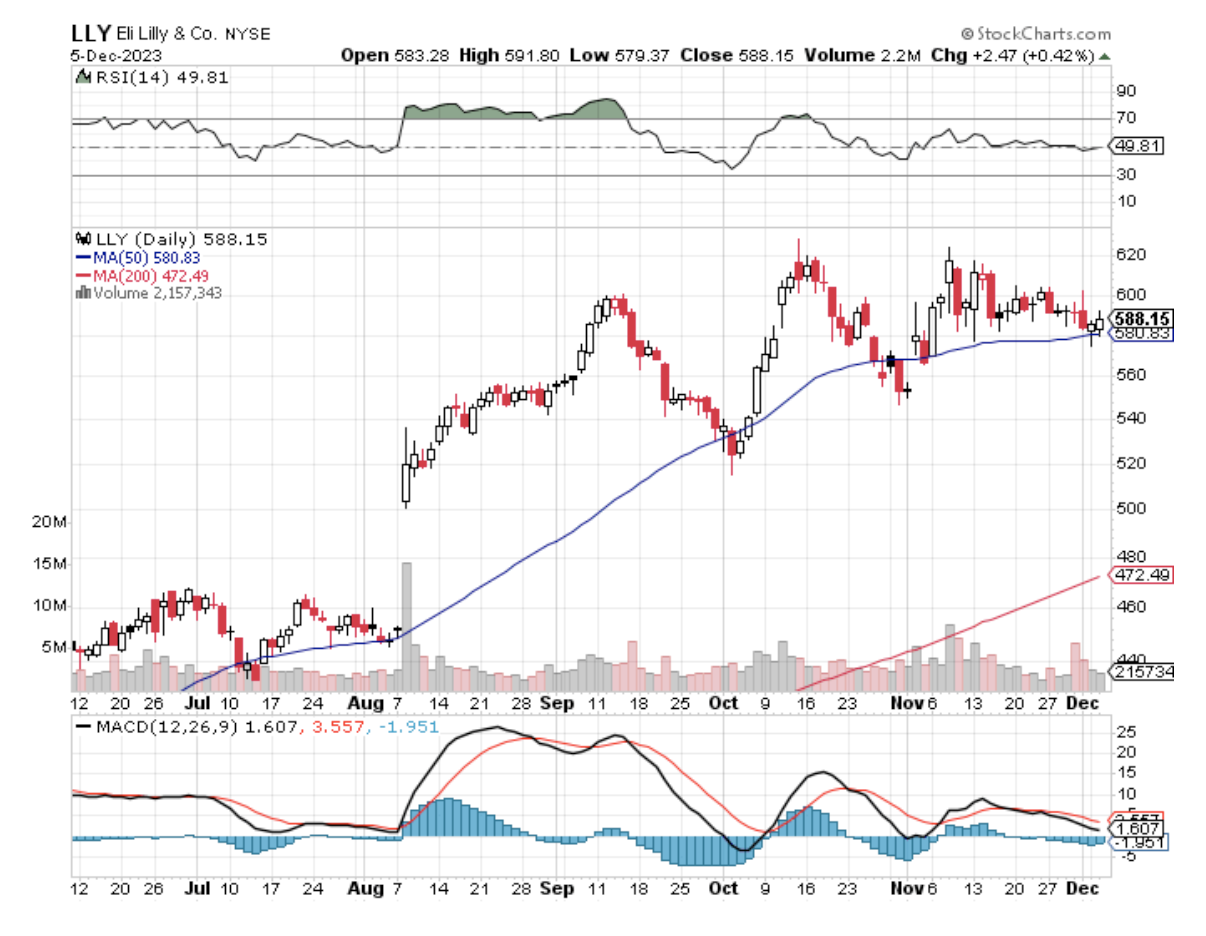
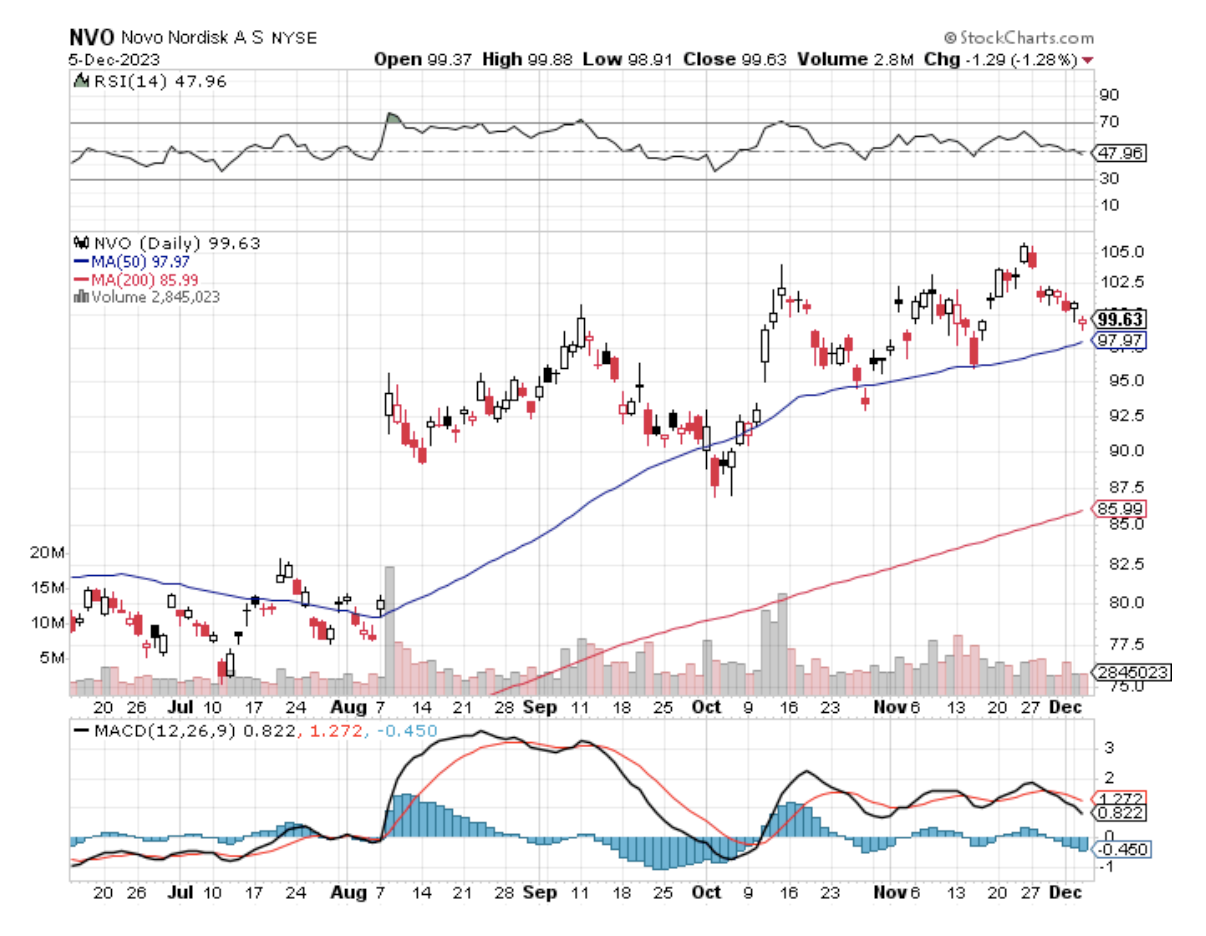
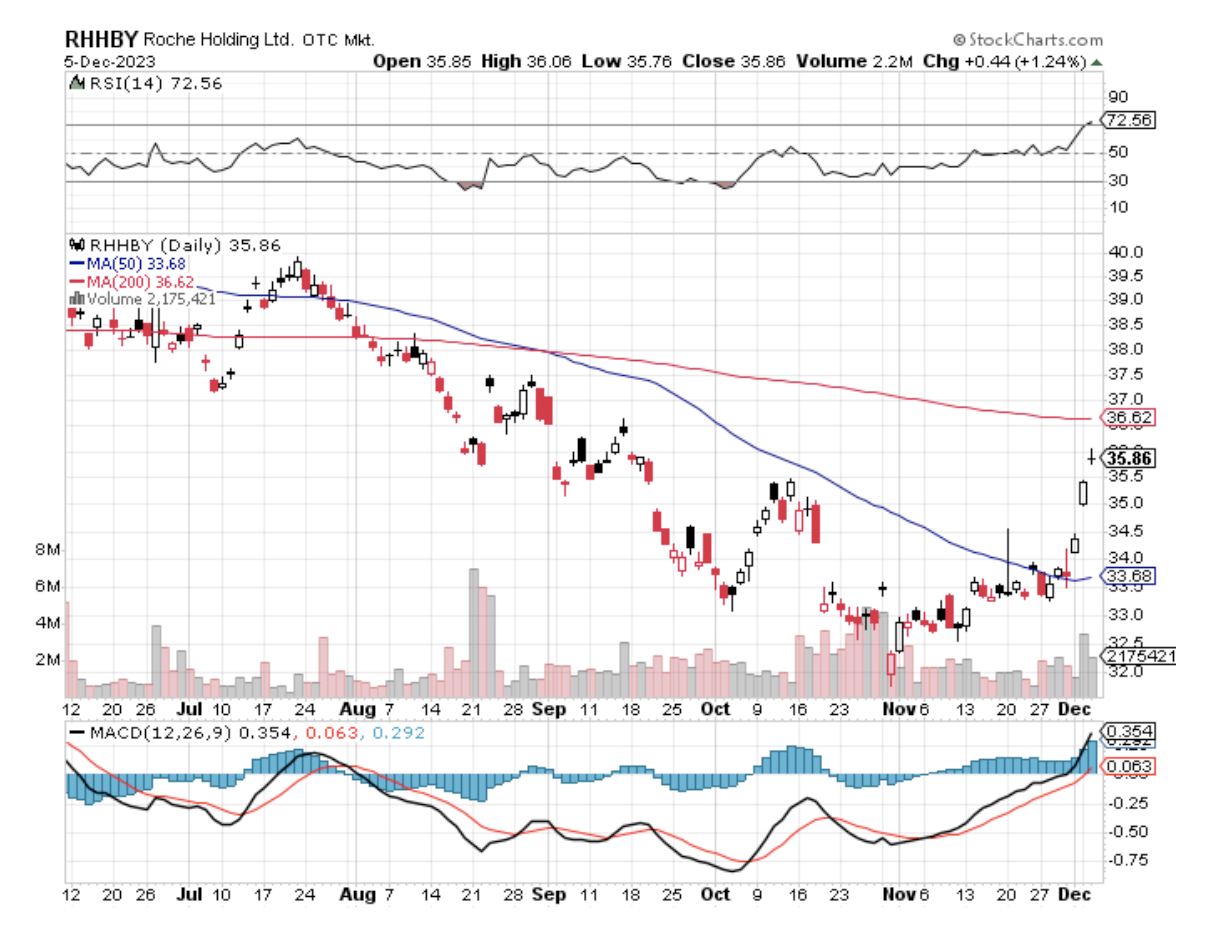

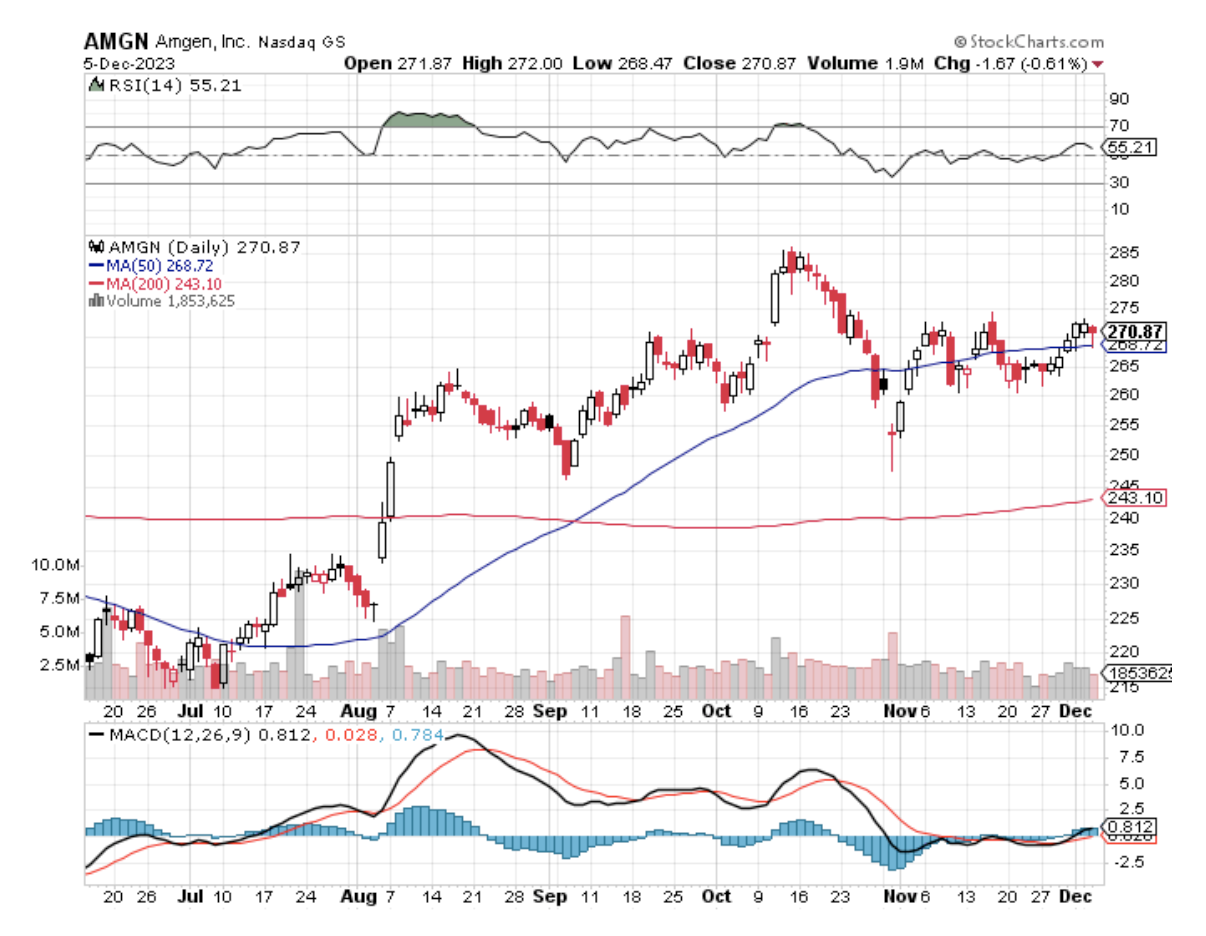
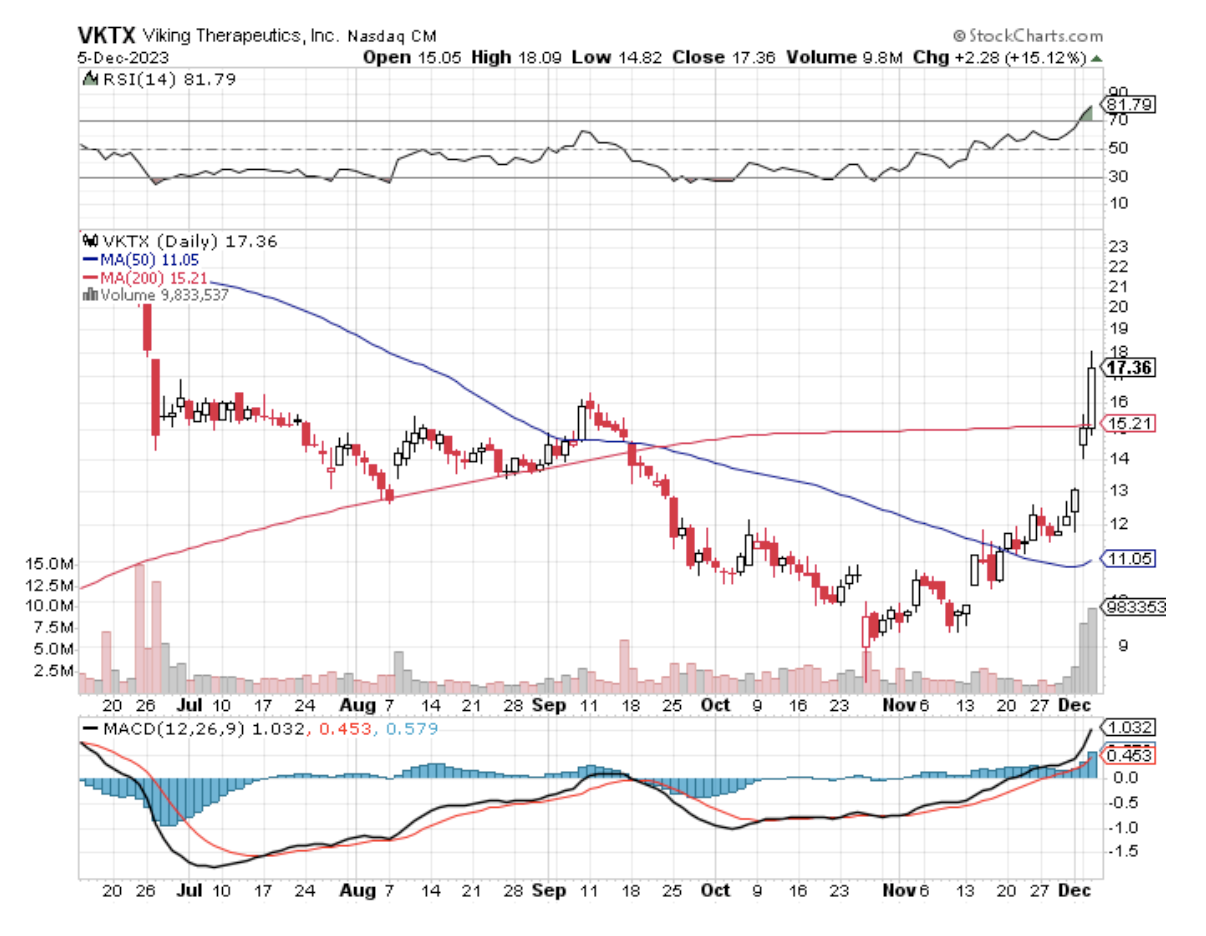
Mad Hedge Biotech and Healthcare Letter
November 16, 2023
Fiat Lux
Featured Trade:
(A GENE GENIE AGAINST CHOLESTEROL)
(VERV), (CRSP), (BEAM), (NVO), (AMGN), (REGN)

CRISPR technology, long heralded as a game-changer in genomics, stands on the brink of a major leap forward. For years, its potential has simmered, but now, it's poised to ignite, promising scientific breakthroughs and significant investment opportunities.
Several pioneering companies employing CRISPR for editing human genomes are at the forefront of this revolution. Their goal? To treat, and potentially cure, a range of genetic diseases. The approaches are twofold: ex vivo, where genes are edited outside the body, and in vivo, with modifications made directly within the body.
Investing in CRISPR gene-editing stocks, however, is not for the faint-hearted. These stocks are characterized by high risk and volatility, demanding a specific investor profile: one that is aggressive and comfortable with risk. For such investors, a company worth considering is Verve Therapeutics (VERV).
Verve stands out, partly due to its relatively modest size with a market capitalization of $732 million. This contrasts sharply with industry peers like CRISPR Therapeutics (CRSP) and Beam Therapeutics (BEAM), valued at $4.47 billion and over $2 billion, respectively. The reason behind Verve's smaller scale is its developmental stage, which lags behind its counterparts.
Established in 2018, Verve has been hailed as a potential leader in next-generation gene therapy, particularly base editing.
You can think of base editing as using a fine-tipped pen to precisely change just one letter in the DNA sequence, without cutting the DNA strand.
In our DNA, there are four "letters" (bases) – A, T, C, and G. Base editing lets scientists directly convert one letter to another (like changing an 'A' to a 'G') without cutting the DNA. This is like fixing a typo in a sentence by carefully erasing one letter and writing in the correct one.
This method is often more precise than CRISPR and less likely to introduce errors because it doesn't involve cutting the DNA strand.
Verve has capitalized on this technology, in-licensed from base-editing pioneer Beam Therapeutics. The company's flagship candidate, VERVE-101, targets heterozygous familial hypercholesterolemia (HeFH), a rare cholesterol disorder.
Needless to say, the stakes are high. The HeFH market is projected to balloon to nearly $60 billion by 2033, positioning VERVE-101 as a potential one-time functional cure and a standard of care in this lucrative market.
Recently, Verve announced that there was a substantial reduction in patients' high cholesterol levels in the first human test of base editing. Despite this, the stock experienced a sharp 41% drop, possibly a misinterpretation of the positive news in an unfriendly biotech market.
The data presented showed Verve's treatment leading to a 40%-55% decrease in harmful LDL cholesterol levels in patients with genetically high cholesterol levels. Verve's approach targets and inactivates the defective gene responsible for high cholesterol levels.
The treatment, however, faced challenges. Two of the Verve-101 trial participants suffered heart attacks, one of which was fatal.
It's crucial to note that the trial specifically included older patients with advanced heart disease, who were already at a heightened risk for cardiac events. The overall safety measures in the study were satisfactory, though, so the FDA has since authorized an expansion of the Phase 1 trial.
Notably, Eli Lilly (LLY) reviewed the trial's results before deciding to buy an option to partner on the Verve treatment. Lilly's decision on teaming up on the cholesterol treatment is expected next year, following the completion of Phase 1 trials.
Additionally, Verve plans to initiate trials for another base-edited therapy, VERVE-102, in the first half of 2024, potentially offering enhanced patient outcomes.
Verve’s trial results match that seen with established medications such as Novartis' Leqvio (NVS), Amgen's Repatha (AMGN), and Regeneron Pharmaceuticals' Praluent (REGN), which are all approved long-term drug therapies.
However, despite the availability of statins and new treatments, a significant portion of these patients fail to maintain healthy cholesterol levels due to cost, treatment adherence issues, or inconsistent healthcare access.
This is where the biotech company’s solution shines. Verve's ultimate goal is to develop a one-and-done treatment to lower cholesterol in the 50 million adults at risk for cardiovascular disease.
While Verve remains a preclinical-stage biotech, its prospects are promising. Its market cap, though modest compared to the commercial opportunity of a functional cure for HeFH, hints at significant growth potential.
With Lilly's track record in developing drugs for underserved conditions, Verve emerges as a compelling investment for those with a high tolerance for risk and an eye on future biotech breakthroughs. I suggest you put this stock on your watchlist.
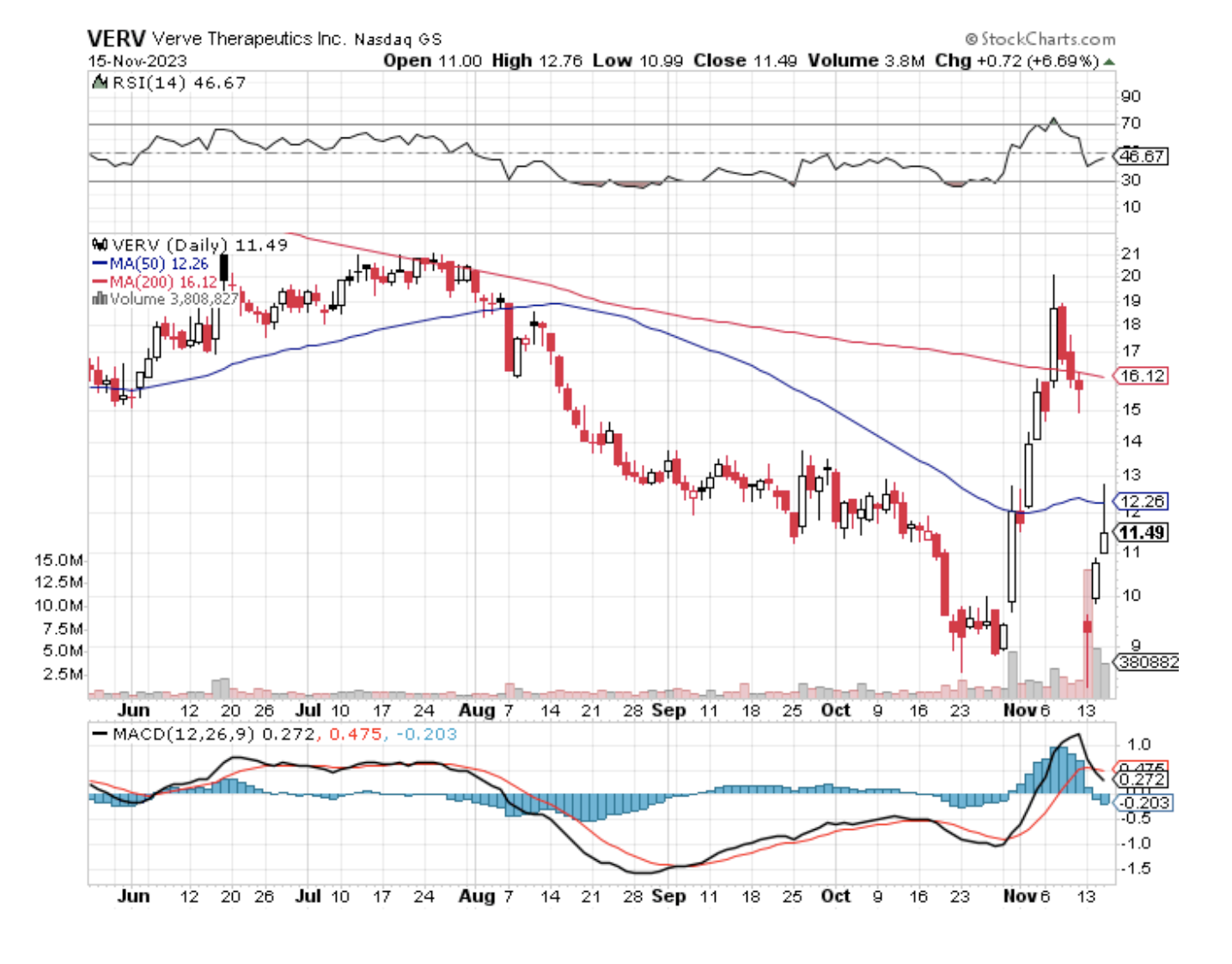
Mad Hedge Biotech and Healthcare Letter
November 2, 2023
Fiat Lux
Featured Trade:
(SLICING THROUGH DOUBT)
(CRSP), (VRTX), (BLUE), (BEAM), (AMGN), (REGN)
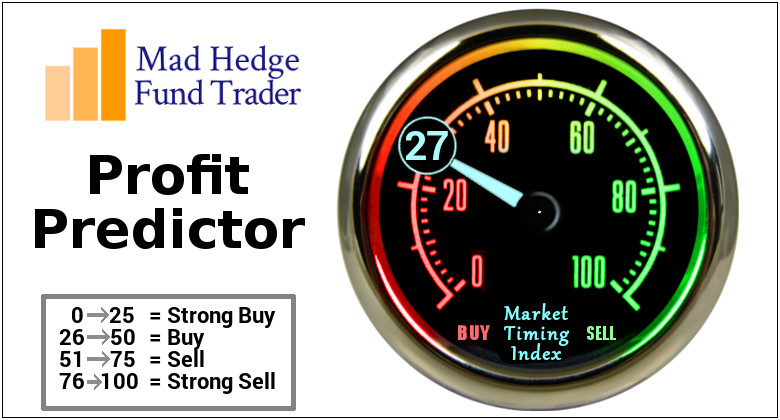
In the intricate world of medical breakthroughs, September 14, 1990, stands out like a sore thumb—or perhaps, a healing one.
On this day, the baseball world was left agog as Ken Griffey Jr. and Sr. knocked out back-to-back home runs, a feat as rare as hen’s teeth.
Meanwhile, in a quieter corner of the planet, a medical marvel was unfolding. Ashanti DeSilva, a 4-year-old with a genetic disorder ravaging her immune system, was about to become the poster child for gene therapy, receiving a groundbreaking treatment that involved a cocktail of modified white blood cells. The aim? To supercharge her immune system and give her a fighting chance at a normal life.
But let’s not sugarcoat it—the road from there to here was anything but a walk in the park. Gene therapy, the promising prodigy of the biotechnology and healthcare sector, had its fair share of teenage rebellion, grappling with safety concerns and delivery vehicle dilemmas. It wasn’t until the early 2010s when gene correction technologies got their act together and safer delivery systems stepped onto the scene, that gene therapy started living up to its potential.
Enter Sickle Cell Disease (SCD), the blood disorder that’s been playing hard to get, affecting around 70,000 Americans and causing everything from anemia to organ damage.
The cure seemed as elusive as a winning lottery ticket until exa-cel, the brainchild of CRISPR Therapeutics (CRSP) and Vertex Pharmaceuticals (VRTX), entered the scene.
This therapy, wielding the mighty CRISPR/Cas9 like a genetic scalpel, takes a patient's stem cells on a rollercoaster ride—harvesting, modifying, and infusing them back into the patient, with the end goal of producing healthy red blood cells.
Looking ahead, CRISPR Therapeutics and Vertex are gearing up for a potential launch of exa-cel in 2024, assuming all the stars align. This innovative gene therapy is poised to be a significant growth catalyst for both companies in the coming decade. Initially, the focus will be approximately 32,000 patients suffering from SCD and TDT.
However, investors need to brace themselves for the price tag, as gene editing therapies don't come cheap. The cost for exa-cel is anticipated to be well north of $1 million, reflecting the complexity and value of this cutting-edge treatment.
At this point, it's crucial to acknowledge that exa-cel is not the only player in this high-stakes game.
A variety of other gene therapies are also vying for the spotlight, with contenders like Bluebird Bio's (BLUE) lovo-cel, Beam Therapeutics' (BEAM) innovative base-edited candidates, and Editas Medicine's (EDIT) competitive CRISPR/Cas9 therapy all in the running.
Now, let’s talk turkey. The financial forecast for exa-cel is looking bright, with CRISPR Therapeutics poised to tap into a $48 billion market opportunity.
Although the treatment has yet to gain FDA approval, the company already has its ducks in a row. It set up 50 treatment centers in the US and 25 in Europe, as well as schmoozed with commercial payers to ensure exa-cel is as accessible as a cold beer on a hot day.
Still, let’s not put on our rose-colored glasses just yet. The biotech sector is as fickle as a cat on a hot tin roof, with CRISPR Therapeutics’ market cap doing the cha-cha in response to industry volatility. With a slew of gene therapies for SCD waiting in the wings, it’s a stark reminder that in biotech, it’s not enough to keep up—you’ve got to lead the pack.
Meanwhile, CRISPR Therapeutics is flexing its muscles with six other clinical trial programs targeting a spectrum of conditions from various cancers to type 1 diabetes, where it is ambitiously seeking a functional cure. With a robust $1.8 billion in cash, equivalents, and marketable securities as of the second quarter and a market capitalization of $3.2 billion, the company is in a strong financial position.
For the astute investors, the real gold is in playing the long game. Rather than getting caught up in the short-term ebbs and flows of the biotech market, the savvy should be pondering how to leverage the current market conditions to their advantage.
After all, CRISPR Therapeutics, with its pioneering gene-editing technology, has the potential to follow in the footsteps of biotech titans like Amgen (AMGN) and Regeneron Pharmaceuticals (REGN), both of which have turned early investments into veritable treasure troves.
Moreover, its financial stability, bolstered by its partnership with Vertex, ensures that funding woes common among smaller biotechs are less of a concern. While it may not be the largest or most prominent player in the biotech arena, the next decade could very well see CRISPR Therapeutics delivering returns that outpace the market. I suggest you buy the dip.

Mad Hedge Biotech and Healthcare Letter
October 17, 2023
Fiat Lux
Featured Trade:
(AN EXCELLENT BLUEPRINT FOR SUCCESS)
(AMGN), (ABBV), (BMY)
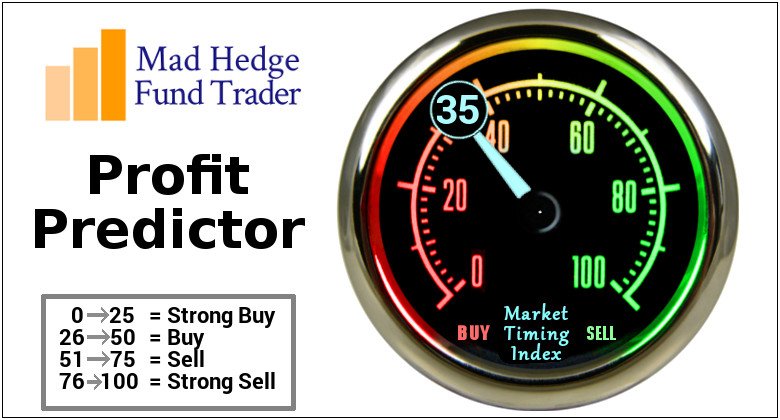
Dividends, the consistent source of passive income, have long anchored many investment portfolios. For stock market investors, particularly those with an eye on the biotechnology and healthcare sector, dividends offer both stability and potential growth.
However, the landscape of dividends is not without its pitfalls. A significant concern for investors is when a company decides to cut or suspend these payouts. So, how can one navigate this challenge? The key is to pinpoint corporations that not only offer dividends but are also poised for sustained growth.
This brings us to a prime example: Amgen (AMGN).
Amgen, in recent times, has grappled with challenges that are not uncommon in the pharmaceutical world. The competitive landscape has chipped away at the market share of some of its flagship drugs, leading to a stagnation in revenue growth.
New therapies, like the asthma treatment Tezspire, have received approval but have yet to be the sales catalysts the company might have hoped for. However, it's crucial to understand that in the pharmaceutical industry, stagnation is not a death sentence but a call to innovate and adapt.
Recognizing the need for strategic growth, Amgen unveiled its plans to acquire Horizon Therapeutics for $28.3 billion in cash.
Horizon, specializing in rare autoimmune diseases, offers a rich pipeline of over 20 programs and an array of approved products. This move is not just an expansion; it's a strategic enhancement of Amgen's portfolio.
After some initial regulatory challenges, the acquisition was sealed on October 6, 2023, at $116.50 per share in cash, amounting to an equity value of $27.8 billion.
Now, let's delve into the numbers. Horizon reported a revenue of $3.6 billion for the year ending June 30, 2023, and an operating income of $513 million. When we juxtapose these figures against Amgen's performance, projections suggest that Horizon could amplify Amgen's annual revenue by a notable 12% to 14%.
As of October 9, 2023, Amgen's equity value stood at approximately $143 billion, translating to an equity value to an annual revenue ratio of 5.3x. In comparison, Horizon's ratio is 7.9x.
For the discerning investor, these figures hint at Amgen's belief in Horizon's potential to be a significant revenue generator.
But Amgen's story doesn't end with Horizon. The company's resilience is evident in its global strategies.
The inclusion of Repatha on China’s National Reimbursement Drug List as of January 1, 2022, bore fruit, with sales jumping from $388 million in the first quarter of this year to $424 million by the second quarter.
Even drugs like Enbrel and XGEVA, which faced concerns about increased competition, have shown promising sales trajectories. By the second quarter of 2023, Amgen's total product sales touched $6,683 million, a 14% leap from the previous quarter.
With a global footprint and encouraging data for drugs like Tarlatamab and LUMAKRAS, Amgen's revenue projections of $26.6 billion to $27.4 billion for 2023 seem well within reach.
Diversification is another feather in Amgen's cap. Beyond acquisitions, the company is nurturing a robust pipeline with numerous programs in development.
Venturing into the biosimilar market, Amgen is crafting alternatives to blockbuster drugs to compete with the more expensive options offered by the likes of Bristol Myers Squibb (BMY) and AbbVie (ABBV). In an era where affordable healthcare is not just a demand but a necessity, this strategy could further cement Amgen's position in the market.
In the intricate world of biotech investing, adaptability is the rhythm, and forward-thinking is the step. Challenges, while inevitable, are also opportunities in disguise. Strategic decisions, exemplified by Amgen's acquisition of Horizon, can chart the path for sustained growth.
For investors, the numbers are compelling. A dividend growth of 61% over five years, a competitive yield of 3.26%, and a forward P/E ratio of 14.3 paint a picture of stability and promise.
Ultimately, Amgen's journey in the biotech sector underscores the significance of adaptability, innovation, and strategic growth. In an industry marked by rapid changes and high stakes, the company emerges as a symbol of resilience.
For investors with an eye on biotechnology and healthcare, Amgen offers not just dividends but a vision of sustained growth and stability, making it an investment worth considering. I suggest you buy the dip.
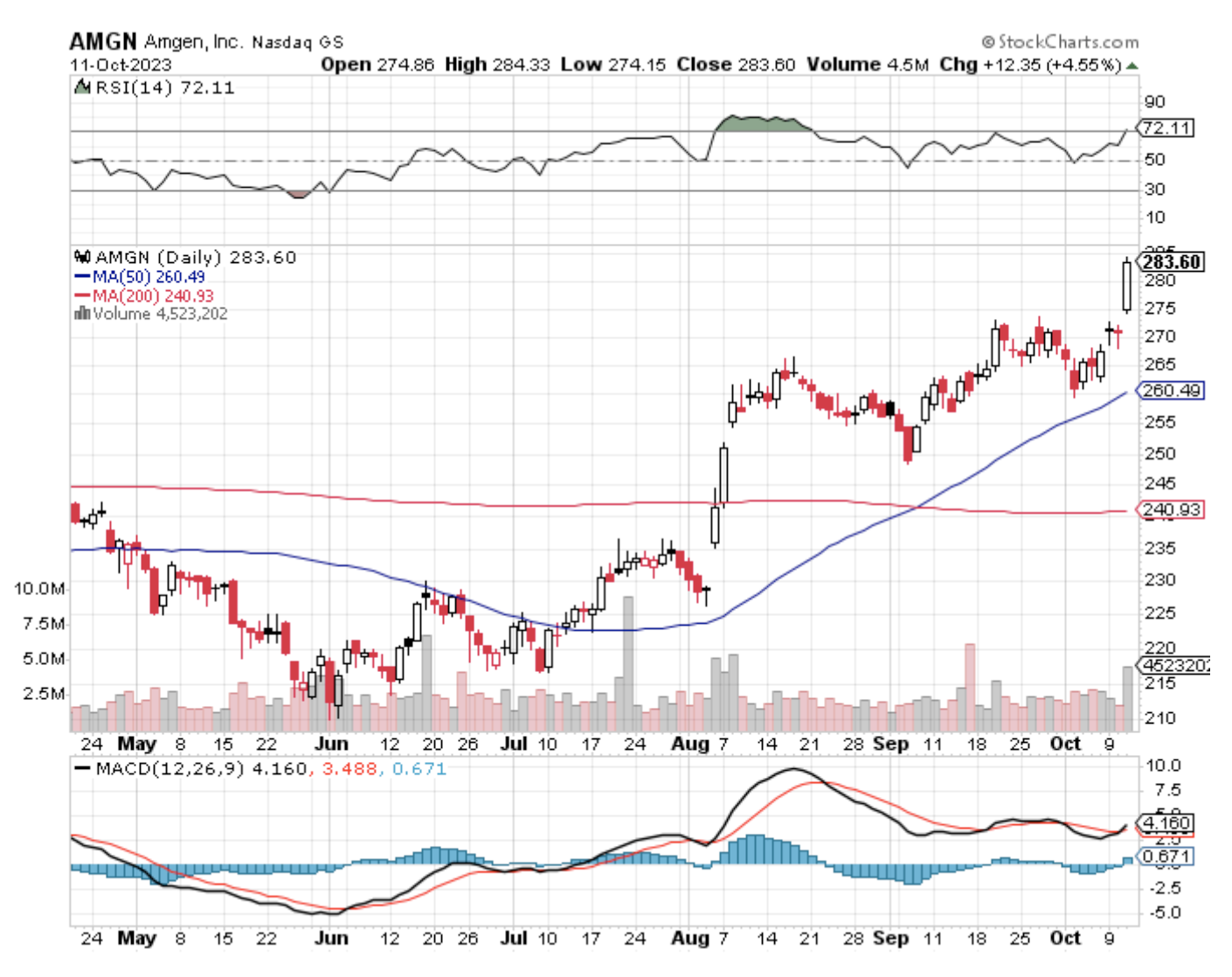
Legal Disclaimer
There is a very high degree of risk involved in trading. Past results are not indicative of future returns. MadHedgeFundTrader.com and all individuals affiliated with this site assume no responsibilities for your trading and investment results. The indicators, strategies, columns, articles and all other features are for educational purposes only and should not be construed as investment advice. Information for futures trading observations are obtained from sources believed to be reliable, but we do not warrant its completeness or accuracy, or warrant any results from the use of the information. Your use of the trading observations is entirely at your own risk and it is your sole responsibility to evaluate the accuracy, completeness and usefulness of the information. You must assess the risk of any trade with your broker and make your own independent decisions regarding any securities mentioned herein. Affiliates of MadHedgeFundTrader.com may have a position or effect transactions in the securities described herein (or options thereon) and/or otherwise employ trading strategies that may be consistent or inconsistent with the provided strategies.
This site uses cookies. By continuing to browse the site, you are agreeing to our use of cookies.
OKLearn moreWe may request cookies to be set on your device. We use cookies to let us know when you visit our websites, how you interact with us, to enrich your user experience, and to customize your relationship with our website.
Click on the different category headings to find out more. You can also change some of your preferences. Note that blocking some types of cookies may impact your experience on our websites and the services we are able to offer.
These cookies are strictly necessary to provide you with services available through our website and to use some of its features.
Because these cookies are strictly necessary to deliver the website, refuseing them will have impact how our site functions. You always can block or delete cookies by changing your browser settings and force blocking all cookies on this website. But this will always prompt you to accept/refuse cookies when revisiting our site.
We fully respect if you want to refuse cookies but to avoid asking you again and again kindly allow us to store a cookie for that. You are free to opt out any time or opt in for other cookies to get a better experience. If you refuse cookies we will remove all set cookies in our domain.
We provide you with a list of stored cookies on your computer in our domain so you can check what we stored. Due to security reasons we are not able to show or modify cookies from other domains. You can check these in your browser security settings.
These cookies collect information that is used either in aggregate form to help us understand how our website is being used or how effective our marketing campaigns are, or to help us customize our website and application for you in order to enhance your experience.
If you do not want that we track your visist to our site you can disable tracking in your browser here:
We also use different external services like Google Webfonts, Google Maps, and external Video providers. Since these providers may collect personal data like your IP address we allow you to block them here. Please be aware that this might heavily reduce the functionality and appearance of our site. Changes will take effect once you reload the page.
Google Webfont Settings:
Google Map Settings:
Vimeo and Youtube video embeds:
